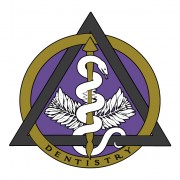Do you know the meaning behind the official symbol of dentistry?

As with many things, the symbol has its origins in mythology. Enter Asclepius – one of the earlier gods associated with health. Asclepius was a son of Apollo (who you may recognize as the god who drives the chariot across the sky each day, bringing the sun with him). Apollo was known for healing, among other things.
Asclepius was primarily known for his healing abilities, and his symbol was a staff entwined with a snake. Believed to have taken the form of a serpent, the story goes that Asclepius healed the Greek people that were suffering from a Roman plague.
Although snakes have a negative connotation today, from a mythological standpoint, the snake was a creature of rebirth. They saw the shedding of its skin as a rejuvenation, a healing. You’ll notice that his symbol is also very similar to the symbol of medicine, the Caduceus; a winged staff with two snakes twirling around it.
Interestingly enough, the serpent has a healing representation in the Old Testament too! Moses made a brass serpent, put it on a pole, and “… if a serpent had bitten any man, when he beheld the serpent of brass, he lived.” (Numbers 21:9) This is also connected to the origins of the Caduceus.
Also appearing on the symbol of dentistry are two branches of leaves with berries on them. This is a very specific reference to the number of teeth people have. There are 32 leaves, for 32 permanent (adult) teeth, and 20 berries, representing primary (children’s) teeth.
The triangle is actually the greek letter Δ, delta, here referring to “dentistry”. The circle is Ο, omicron. Omicron represents “odont” – the greek word for tooth. The two symbols are woven together. The purple color is actually lilac, and was selected as the color of dentistry by the NADF (National Association of Dental Faculties) in 1897.
Symbols and logos are never what they appear to be at face value. Each element is carefully chosen, and with a little digging, you too can discover what they really mean. In the meantime, if you need to see a dentist, give Dr. Chauvin a call!




